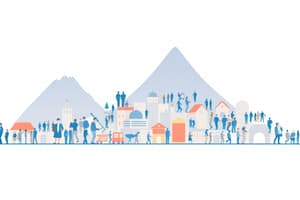Podcast
Questions and Answers
What is a significant trend regarding early marriage in rural areas of Pakistan?
What is a significant trend regarding early marriage in rural areas of Pakistan?
- Females often marry at ages 13-15. (correct)
- A higher marriage age is preferred due to educational attainment.
- The average marriage age is 20-22 years.
- Marriages are commonly delayed until the late twenties.
Which factor contributes to the belief in having more children in rural areas of Pakistan?
Which factor contributes to the belief in having more children in rural areas of Pakistan?
- High urban education levels.
- Government policies promoting family planning.
- Economic incentives for small families.
- Religious beliefs regarding children being blessings. (correct)
What was the total number of Afghan refugees in Pakistan by the late 1980s?
What was the total number of Afghan refugees in Pakistan by the late 1980s?
- 3.2 million (correct)
- 2 million
- 1.4 million
- 5 million
Which of the following is NOT listed as an effect of population growth on the economy of Pakistan?
Which of the following is NOT listed as an effect of population growth on the economy of Pakistan?
How has the education level in urban areas affected the marriage age for females in Pakistan?
How has the education level in urban areas affected the marriage age for females in Pakistan?
What was the average number of children per woman in Pakistan during the 1980s?
What was the average number of children per woman in Pakistan during the 1980s?
What contributes to the high population growth rate in Pakistan?
What contributes to the high population growth rate in Pakistan?
What percentage of illiteracy in Pakistan is contributed by women?
What percentage of illiteracy in Pakistan is contributed by women?
Which group of people migrated to Pakistan after its independence in 1947 and contributed to population growth?
Which group of people migrated to Pakistan after its independence in 1947 and contributed to population growth?
What has been a primary barrier to implementing effective family planning in Pakistan?
What has been a primary barrier to implementing effective family planning in Pakistan?
What should be implemented to improve awareness of birth control in rural areas of Pakistan?
What should be implemented to improve awareness of birth control in rural areas of Pakistan?
What was one major issue faced by Pakistan after absorbing Muhajirs and Afghan refugees?
What was one major issue faced by Pakistan after absorbing Muhajirs and Afghan refugees?
What has not been adequately managed to effectively reduce population growth in Pakistan?
What has not been adequately managed to effectively reduce population growth in Pakistan?
What is population growth primarily determined by?
What is population growth primarily determined by?
What is overpopulation most commonly associated with?
What is overpopulation most commonly associated with?
Which of the following factors does NOT contribute to the high population growth in Pakistan?
Which of the following factors does NOT contribute to the high population growth in Pakistan?
What percentage of Pakistan’s population is urban as of 2020?
What percentage of Pakistan’s population is urban as of 2020?
Which of the following is a significant demographic feature noted for Pakistan's population?
Which of the following is a significant demographic feature noted for Pakistan's population?
Why has there been a delay in conducting nationwide censuses in Pakistan?
Why has there been a delay in conducting nationwide censuses in Pakistan?
What is the estimated population of Pakistan in 2020 according to UN data?
What is the estimated population of Pakistan in 2020 according to UN data?
Which of the following is NOT a reason for overpopulation in Pakistan?
Which of the following is NOT a reason for overpopulation in Pakistan?
Flashcards
What is population?
What is population?
The total number of people living in a specific area, such as a country, city, or district.
What is population density?
What is population density?
The number of people per square kilometer (or square mile) of land area.
What is overpopulation?
What is overpopulation?
A situation where the population grows faster than the available resources, leading to strain on those resources.
What is population growth rate?
What is population growth rate?
Signup and view all the flashcards
What is a high fertility rate?
What is a high fertility rate?
Signup and view all the flashcards
What is a high infant mortality rate?
What is a high infant mortality rate?
Signup and view all the flashcards
What is lack of birth control?
What is lack of birth control?
Signup and view all the flashcards
What is a census?
What is a census?
Signup and view all the flashcards
Population Growth Rate
Population Growth Rate
Signup and view all the flashcards
Fertility Rate
Fertility Rate
Signup and view all the flashcards
Mortality Rate
Mortality Rate
Signup and view all the flashcards
Birth Control
Birth Control
Signup and view all the flashcards
Literacy
Literacy
Signup and view all the flashcards
International Migration
International Migration
Signup and view all the flashcards
Natural Population Growth
Natural Population Growth
Signup and view all the flashcards
Infant Mortality Rate
Infant Mortality Rate
Signup and view all the flashcards
Early Marriage Age in Rural Pakistan
Early Marriage Age in Rural Pakistan
Signup and view all the flashcards
Religious Beliefs on Population Growth
Religious Beliefs on Population Growth
Signup and view all the flashcards
Brain Drain and Population Growth
Brain Drain and Population Growth
Signup and view all the flashcards
Population Growth Impact on Living Standards
Population Growth Impact on Living Standards
Signup and view all the flashcards
Men to Land Ratio and Population Growth
Men to Land Ratio and Population Growth
Signup and view all the flashcards
Study Notes
Population Growth - Causes and Effects
- Population growth is measured by the average annual percentage change, resulting from the surplus of births over deaths and migration.
- This change can be positive or negative, affecting a country's resources, infrastructure, and job market.
- Population density in Pakistan, in 2017, varied significantly across regions.
- The last Pakistani census took place in 2017. There have only been six nationwide censuses since 1951.
- Overpopulation is the idea of a larger population than available resources.
- Pakistan's 2020 population was estimated at 220,892,340 people. This is equivalent to 2.83% of the global population.
- Pakistan ranks 5th in the world by population.
- Pakistan's population density is 287 per km² (742 per mi²).
- The total land area is 770,880 km² (297,638 sq. miles).
- The median age in Pakistan is 22.8 years.
- 35.1% of the population is urban.
Causes of Explosive Population Growth in Pakistan
- High fertility rate (6.7% in the 1980's, declining to 4-5 in 1990's)
- High infant mortality rate
- Poor birth control awareness
- Lack of awareness and illiteracy
- Migration from other countries
- Inadequate government policies and poor family planning programs
- Early marriage of females
- Cultural and religious factors
- High mortality rate decreasing in more recent years
Additional Factors Influencing Population Growth
- High fertility rate in a temperate climate contributing to higher birth rates.
- Lack of advanced medical facilities in rural areas impacts differences in birth and death rates.
- Need for better access to birth control and family planning efforts.
- Mass migration of people from neighboring countries, particularly Afghanistan.
Effects of Population Growth in Pakistan
- Impact on GDP/GNP
- Strain on natural resources
- Ratio of men to land
- Per capita income
- Ecosystem impact
- Living standards
- Strain on agricultural systems
- Unemployment
- Strain on social infrastructure
- Capital formation
- Environmental concerns
- Brain drain
- Physiological disorders
Studying That Suits You
Use AI to generate personalized quizzes and flashcards to suit your learning preferences.



